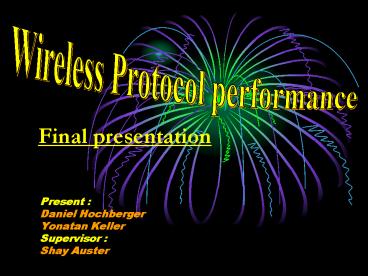Present : - PowerPoint PPT Presentation
1 / 38
Title:
Present :
Description:
Present : Daniel Hochberger. Yonatan Keller. Supervisor : Shay Auster ... Working over a TDMA wireless and clean network. ... Implementing an acknowledgment ... – PowerPoint PPT presentation
Number of Views:20
Avg rating:3.0/5.0
Title: Present :
1
Wireless Protocol performance
Final presentation
- Present
- Daniel Hochberger
- Yonatan Keller
- Supervisor
- Shay Auster
2
Project goals
- Working over a TDMA wireless and clean network .
- Design of layer algorithm upon a changing
transmission rates network. - Optimize the network by
- Developing a MAC algorithm and a unify layer
algorithm to unify/separate packets. - Implementing an acknowledgment mechanism over the
network. - Collect statistics and analyze algorithm
performances. - Learn OPNET simulation environment.
3
General design
4
General design
Data source
Unifying layer
Ack source
MAC layer (ARQ)
TDMA layer
Physical layer
5
General Design
Transmitter busy state
Actual transmission rate
6
Packet format
SRC Id
DST Id
DATA
RN
ACK
SRC Id
DST Id
ACK
RN
SN
RN
DATA N
DATA 1
DATA 2
7
Unifying process
8
Instant Throughput Optimization
- No unified packets
S
- Unifying 5 packets into 1
S ( 5 1024) / ( 160 5 1024 ) 96.9
- Unifying 10 packets into 1
S ( 10 1024) / ( 160 10 1024 ) 98.4
9
Optimal Unified Packet Size (example)
- Time slot 1s
- Transmission rate 12000 b/s
- Little packet size 1024 bits
- Sim time 30s
- Optimal number of little packets unified 11
- Optimal unified packet size 12000 bits
10
Unifying implementation and features
- Select the unified packets size
- To be optimal
- At running time
- According to
- The actual transmission rate
- The amount of unified packets per slot
11
Unifying packets performances (amount 1)
12
Unifying features (2)
- Unifying process implemented as a queue
For a creation rate big enough, NO DELAY in
unifying process!
- Number of unified packets irrelevant for the
same transmission rates, will be always the same!
13
Unifying results (1)
Amount1
38000
Amount4
26000
Amount10
15500
14
Unifying results (2)
Amount1
0.97
Amount4
0.92
Amount10
0.90
15
Unifying results (3)
More little packets received
Optimal unified size
Amount
Higher throughput
Result
Unifying bigger packets
Best performances
16
The TDMA process
17
TDMA features
- Time slot 1s
- Changing rate every 10 minutes
- Adaptable for every number of nodes
- Implemented as a queue in each transmission
slot, sends the maximal number of packets - For sending, checks
- This is my slot
- Ive got enough time to send the packet
- The transmitter is not actually busy
18
TDMA implementation
19
ARQ Protocols
20
Time slot exploitation(StopWait)
- No unified packets
Lost time (waiting for an ack)
Only 20 of the time slot exploited!
- Unified packets 1 big packet 5 little
packets
100 of the time slot exploited!
21
StopWait implementation
22
SW 1 Lost Vs. 5 lost(amount 1)
- 5 lost
- packets received 19000
- 1 lost
- packets received 21000
23
SW 1 lost Vs. 30 lost(amount 1)
- 1 lost
- packets received 21000
- General Throughput ? 0.4
- 30 lost
- packets received 7000
- General Throughput ? 0.25
24
Go-Back-N
Time-out
Sender
0
1
2
3
4
5
2
6
3
4
5
7
ack0
ack2
ack1
3
4
5
7
Receiver
(N6)
25
Selective Repeat
Time-out
Sender
0
1
2
3
4
5
2
2
6
7
ack0
ack1
ack5
6
Receiver
(N6)
26
Go-Back-N/Selective Repeat implementation
27
GB-N/SR ack optimization
- 2.
1
1,2,3,4
ARQ protocol process
TDMA process
2
9,10,11,12 ack only on 4!
1
Ack
ARQ updates the ack field of the first packet in
the TDMA queue immediately
5,6,7,12,13 ack only on 12!
2
28
GB-N 1 lost Vs. 5 lost
tput 0.9
tput 0.9
packets 39000
packets 41000
(amount 1)
Loosing 1 packet of the frame Loosing 5 packet
of the frame Loosing all the frame !!!
N 10
29
GB-N 1 lost Vs. 30 lost(amount 1)
Tput 0.9
Tput 0.7
packets 25000
packets 41000
30
Influence of the amount of little packets per
unified packet
Need for a bigger amount of little packets into
a unified one
lost
GB-N/SR
StopWait
The amount has no influence!!!
31
GB-N Vs StopWait (Amount4)
?
GB-N
gt
Can exploit a whole slot to send packets
Have to re-transmit a whole frame for each lost
?
32
1 lost GB-N Vs Selective Repeat (amount1)
Tput0.9
Tput0.97
packets received44000
packets received40500
GB-N
SR
33
Results
34
Results (1)
- Unifying packets into bigger ones increase
significantly the performances (throughput
number of transmitted packets)
- The number of little packets unified into a
bigger one has to be optimal to reach good
performances
35
Results (2)
- SW performances can be equivalent to GB-N/SR
only if
- The physical link is clear (0 noise)
- At each slot, a whole unified packet is sent
(amount1)
- For noisy networks, SR gt GB-N gt SW
36
Results (3)
- For a clear physical layer, the amount of little
packets unified into a big one has to be
minimal. - The optimal amount will increase in more noisy
networks (for GB-N or SR).
37
Possibilities of extension
- Changing packet size
- More nodes
- Application to TCP/IP packet
- Changing transmission rate on-line according to
the degree of noise
38
The end
?
Questions































